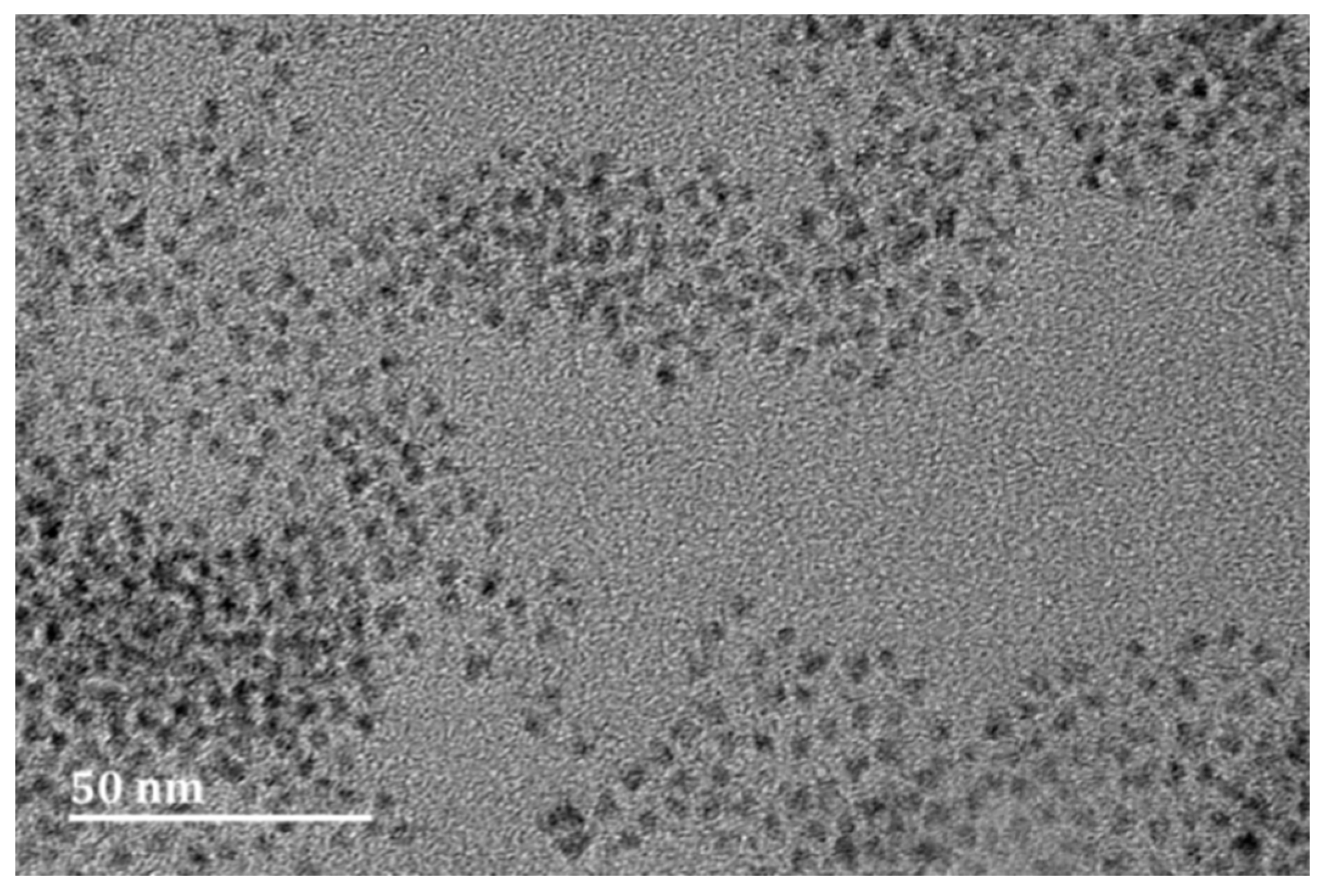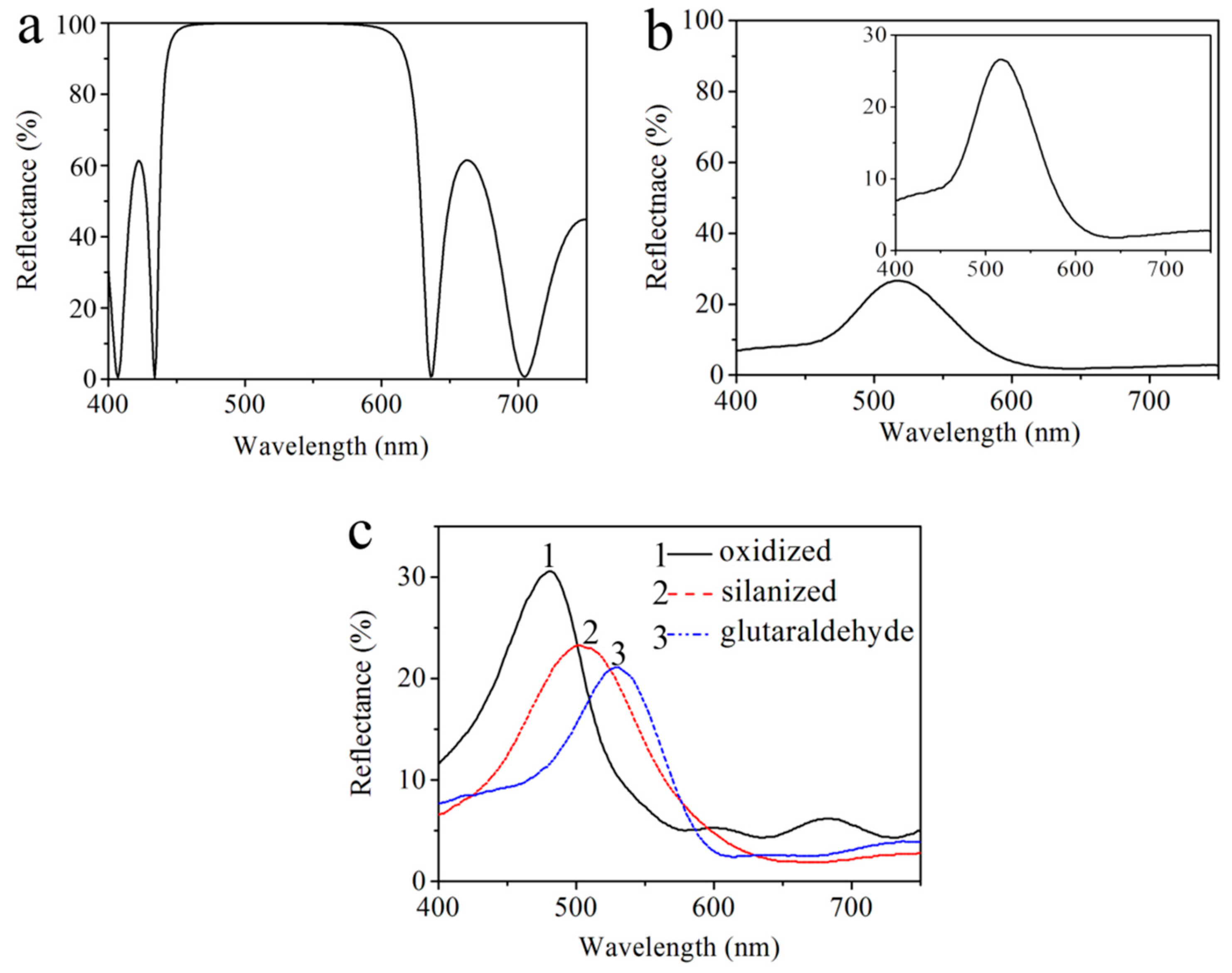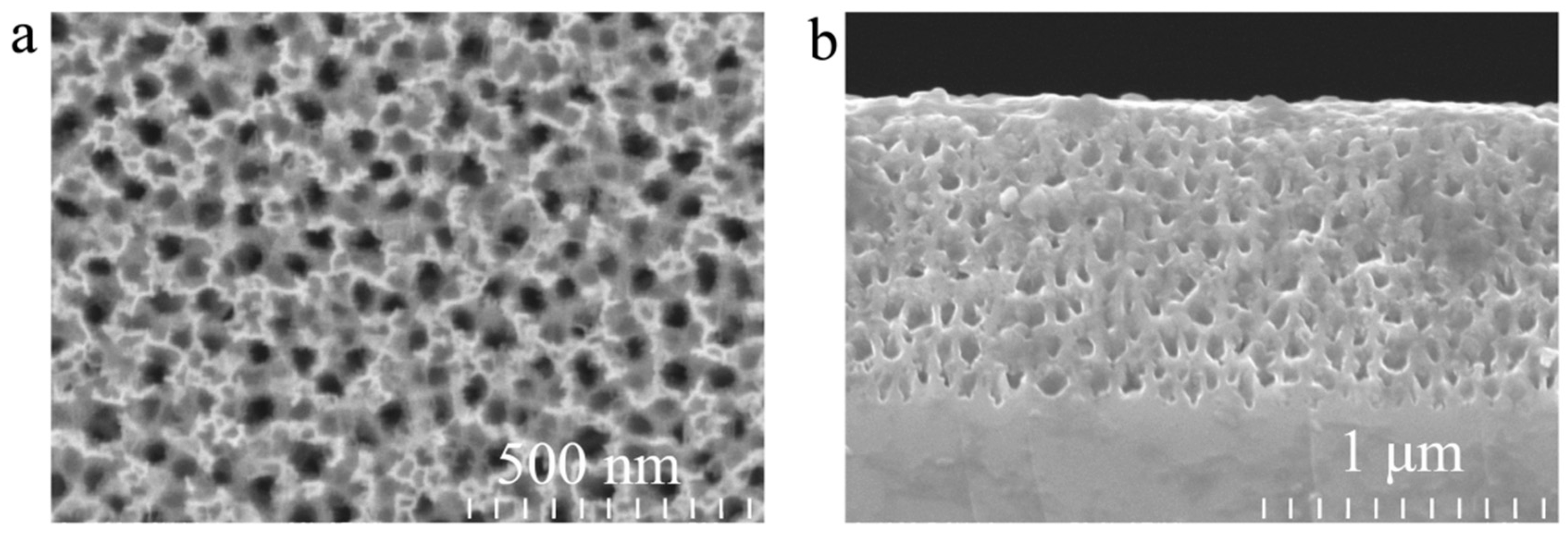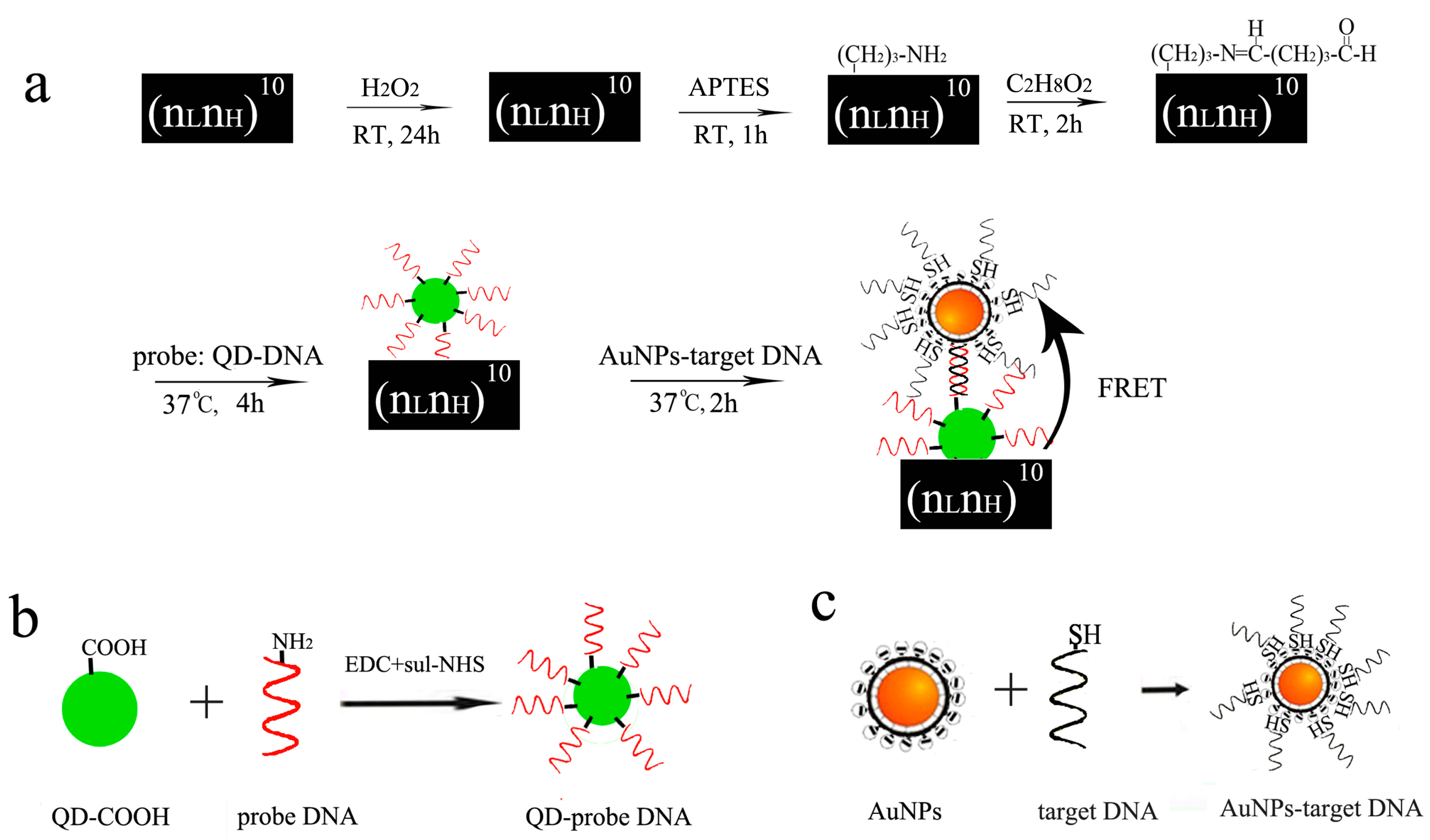Efficient Fluorescence Resonance Energy Transfer between Quantum Dots and Gold Nanoparticles Based on Porous Silicon Photonic Crystal for DNA Detection
Abstract
:1. Introduction
2. Materials and Methods
2.1. Reagents and Chemicals
2.2. Apparatus
2.3. Synthesis of Citrate-Stabilized AuNPs
2.4. AuNPs-Conjugated Target DNA
2.5. QD-Conjugated Probe DNA
2.6. Preparation of Bragg Reflector
2.6.1. Calculations
2.6.2. Fabrication of PS DBR
2.7. Functionalization of PS DBR
2.7.1. Oxidization
2.7.2. Silanization
2.7.3. Immobilization
2.8. Detection
3. Results and Discussion
4. Conclusions
Acknowledgments
Author Contributions
Conflicts of Interest
References
- Stach, J.E.M.; Maldonado, L.A.; Ward, A.C.; Goodfellow, M.; Bull, A.T. New primers for the class Actinobacteria: Application to marine and terrestrial environments. Environ. Microbiol. 2003, 5, 828–841. [Google Scholar] [CrossRef] [PubMed]
- Qin, S.; Miao, Q.; Feng, W.W.; Wang, Y.; Zhu, X.; Xing, K.; Jiang, J.H. Biodiversity and plant growth promoting traits of culturable endophytic Actinobacteria associated with Jatropha curcas L. growing in Panxi dry-hot valley soil. Appl. Soil. Ecol. 2015, 93, 47–55. [Google Scholar] [CrossRef]
- Ettoumi, B.; Chouchane, H.; Guesmi, A.; Mahjoubi, M.; Brusetti, L.; Neifar, M.; Borin, S.; Daffonchio, D.; Cherif, A. Diversity, ecological distribution and biotechnological potential of Actinobacteria inhabiting seamounts and non-seamounts in the Tyrrhenian Sea. Microbiol. Res. 2016, 186–187, 71–80. [Google Scholar] [CrossRef] [PubMed]
- Bilyk, O.; Luzhetskyy, A. Metabolic engineering of natural product biosynthesis in Actinobacteria. Curr. Opin. Biotechnol. 2016, 42, 98–107. [Google Scholar] [CrossRef] [PubMed]
- Schäfer, J.; Jäckel, U.; Kämpfer, P. Development of a new PCR primer system for selective amplification of Actinobacteria. FEMS. Microbiol. Lett. 2010, 311, 103–112. [Google Scholar] [CrossRef] [PubMed]
- Zhang, H.Y.; Jia, Z.H.; Lv, X.Y. Surface layer reflective index changes of Au nanoparticle functionalized porous silicon microcavity for DNA detection. Curr. Appl. Phys. 2015, 15, 870–876. [Google Scholar] [CrossRef]
- Shi, Y.; Pan, Y.; Zhang, H.; Zhang, Z.; Li, M.J.; Yi, C.; Yang, M. A dual-mode nanosensor based on carbon quantum dots and gold nanoparticles for discriminative detection of glutathione in human plasma. Biosens. Bioelectron. 2014, 56, 39–45. [Google Scholar] [CrossRef] [PubMed]
- Yin, Z.; Li, H.; Xu, W.; Cui, S.; Zhou, D.; Chen, X.; Zhu, Y.; Qin, G.; Song, H. Local field modulation induced three-order upconversion enhancement: Combining surface plasmon effect and photonic crystal effect. Adv. Mater. 2016, 28, 2518–2525. [Google Scholar] [CrossRef] [PubMed]
- Salamon, H.; Skopić, M.K.; Jung, K.; Bugain, O.; Brunschweiger, A. Chemical biology probes from advanced DNA-encoded libraries. ACS Chem. Biol. 2016, 11, 296–307. [Google Scholar] [CrossRef] [PubMed]
- Xu, S.; Xu, W.; Wang, Y.F.; Zhang, S.; Zhu, Y.S.; Tao, L.; Xia, L.; Zhou, P.W.; Song, H.W. NaYF4:Yb,Tm nanocrystals and TiO2 inverse opal composite films: A novel device for upconversion enhancement and solid-based sensing of avidin. Nanoscale 2014, 6, 5859–5870. [Google Scholar] [CrossRef] [PubMed]
- Zhu, Y.; Cui, S.; Wang, Y.; Liu, M.; Lu, C.; Mishra, A.; Xu, W. Enhanced rare earth photoluminescence in inverse opal photonic crystals and its application for pH sensing. Nanotechnology 2016, 27, 405202. [Google Scholar] [CrossRef] [PubMed]
- Mariani, S.; Scarano, S.; Spadavecchia, J.; Minunni, M. A reusable optical biosensor for the ultrasensitive and selective detection of unamplified human genomic DNA with gold nanostars. Biosens. Bioelectron. 2015, 74, 981–988. [Google Scholar] [CrossRef] [PubMed]
- Zhou, R.; Xu, C.; Dong, J.; Wang, G. Labeling-free fluorescent detection of DNA hybridization through FRET from pyrene excimer to DNA intercalator SYBR green I. Biosens. Bioelectron. 2015, 65, 103–107. [Google Scholar] [CrossRef] [PubMed]
- Zhang, Y.; Geng, X.; Ai, J.; Gao, Q.; Qi, H.; Zhang, C. Signal amplification detection of DNA using a sensor fabricated by one-step covalent immobilization of amino-terminated probe DNA onto the polydopamine-modified screen-printed carbon. Sens. Actuators B Chem. 2015, 221, 1535–1541. [Google Scholar] [CrossRef]
- Cheng, X.R.; Hau, B.Y.H.; Endo, T.; Kerman, K. Au nanoparticle-modified DNA sensor based on simultaneous electrochemical impedance spectroscopy and localized surface plasmon resonance. Biosens. Bioelectron. 2014, 53, 513–518. [Google Scholar] [CrossRef] [PubMed]
- Li, Z.; Miao, X.; Xing, K.; Zhu, A.; Ling, L. Enhanced electrochemical recognition of double-stranded DNA by using hybridization chain reaction and positively charged gold nanoparticles. Biosens. Bioelectron. 2015, 74, 687–690. [Google Scholar] [CrossRef] [PubMed]
- Zhang, H.; Jia, Z.; Lv, X.; Zhou, J.; Chen, L.; Liu, R.; Ma, J. Porous silicon optical microcavity biosensor on silicon-on-insulator wafer for sensitive DNA detection. Biosens. Bioelectron. 2013, 44, 89–94. [Google Scholar] [CrossRef] [PubMed]
- Ilkhani, H.; Hughes, T.; Li, J.; Zhong, C.J.; Hepel, M. Nanostructured SERS-electrochemical biosensors for testing of anticancer drug interactions with DNA. Biosens. Bioelectron. 2016, 80, 257–264. [Google Scholar] [CrossRef] [PubMed]
- Kurbanoglu, S.; Dogan-Topal, B.; Rodriguez, E.P.; Palabiyik, B.B.; Ozkan, S.A.; Uslu, B. Advances in electrochemical DNA biosensors and their interaction mechanism with pharmaceuticals. J. Electroanal. Chem. 2016, 775, 8–26. [Google Scholar] [CrossRef]
- Li, T.; Byun, J.Y.; Kim, B.B.; Shin, Y.B.; Kim, M.G. Label-free homogeneous FRET immunoassay for the detection of mycotoxins that utilizes quenching of the intrinsic fluorescence of antibodies. Biosens. Bioelectron. 2013, 42, 403–408. [Google Scholar] [CrossRef] [PubMed]
- Huang, X.; Huang, X.; Zhang, A.; Zhuo, B.; Lu, F.; Chen, Y.; Gao, W. Quenching of the electrochemiluminescence of RU-complex tagged shared-stem hairpin probes by graphene oxide and its application to quantitative turn-on detection of DNA. Biosens. Bioelectron. 2015, 70, 441–446. [Google Scholar] [CrossRef] [PubMed]
- Saha, J.; Roy, A.D.; Dey, D.; Chakraborty, S.; Bhattacharjee, D.; Paul, P.K.; Hussain, S.A. Investigation of Fluorescence Resonance Energy Transfer between Fluoresce in and Rhodamine 6G. Spectrochim. Acta A 2015, 149, 143–149. [Google Scholar] [CrossRef] [PubMed]
- Esteve-Turrillas, F.A.; Abad-Fuentes, A. Applications of quantum dots as probes in immunosensing of small-sized analytes. Biosens. Bioelectron. 2013, 41, 12–29. [Google Scholar] [CrossRef] [PubMed]
- Dai, H.; Shi, Y.; Wang, Y.; Sun, Y.; Hu, J.; Ni, P.; Li, Z. A carbon dot based biosensor for melamine detection by fluorescence resonance energy transfer. Sens. Actuators B Chem. 2014, 202, 201–208. [Google Scholar] [CrossRef]
- Li, S.; Qiu, W.; Zhang, X.; Ni, J.; Gao, F.; Wang, Q. A high-performance DNA biosensor based on the assembly of gold nanoparticles on the terminal of hairpin-structured probe DNA. Sens. Actuators B Chem. 2016, 223, 861–867. [Google Scholar] [CrossRef]
- Xu, X.; Qiao, J.; Li, N.; Qi, L.; Zhang, S. Fluorescent probe for turn-on sensing of L-cysteine by ensemble of AuNCs and polymer protected AuNPs. Anal. Chim. Acta 2015, 879, 97–103. [Google Scholar] [CrossRef] [PubMed]
- Bu, D.; Zhuang, H.; Yang, G.; Ping, X. An immunosensor designed for polybrominated biphenyl detection based on fluorescence resonance energy transfer (FRET) between carbon dots and gold nanoparticles. Sens. Actuators B Chem. 2014, 195, 540–548. [Google Scholar] [CrossRef]
- Mohammed, A.M. Fabrication and characterization of gold nano particles for DNA biosensor applications. Chin. Chem. Lett. 2016, 27, 801–806. [Google Scholar] [CrossRef]
- Haidary, S.M.; Mohammed, A.B.; Córcoles, E.P.; Ali, N.K.; Ahmad, M.R. Effect of coatings and surface modification on porous silicon nanoparticles for delivery of the anticancer drug tamoxifen. Microelectron. Eng. 2016, 161, 1–6. [Google Scholar] [CrossRef]
- Hiraoui, M.; Haji, L.; Guendouz, M.; Lorrain, N.; Moadhen, A.; Oueslati, M. Towards a biosensor based on anti resonant reflecting optical waveguide fabricated from porous silicon. Biosens. Bioelectron. 2012, 36, 212–216. [Google Scholar] [CrossRef] [PubMed]
- Wei, X.; Weiss, S.M. Guided mode biosensor based on grating coupled porous silicon wavelength. Opt. Express 2011, 19, 11330–11339. [Google Scholar] [CrossRef] [PubMed]
- Sanger, A.; Kumar, A.; Chauhan, S.; Gautam, Y.K.; Chandra, R. Fast and reversible hydrogen sensing properties of Pd/Mg thin film modified by hydrophobic porous silicon substrate. Sens. Actuators B Chem. 2015, 213, 252–260. [Google Scholar] [CrossRef]
- Liu, C.; Jia, Z.; Lv, X.; Lv, C.; Shi, F. Enhancement of QDs’ fluorescence based on porous silicon Bragg reflector. Phys. B 2015, 457, 263–268. [Google Scholar] [CrossRef]
- Kim, H.G.; Lee, K.W. Electrostatic gas sensor with a porous silicon diaphragm. Sens. Actuators B Chem. 2015, 219, 10–16. [Google Scholar] [CrossRef]
- Park, J.; Yanagida, Y.; Hatsuzawa, T. Fabrication of p-type porous silicon using double tank electrochemical cell with halogen and LED light sources. Sens. Actuators B Chem. 2016, 233, 136–143. [Google Scholar] [CrossRef]
- Miao, Y.; Gan, N.; Li, T.; Cao, Y.; Hu, F.; Chen, Y. An ultrasensitive fluorescence aptasensor for chloramphenicol based on FRET between quantum dots as donor and the magnetic SiO2@AuNPs probe as acceptor with exonuclease-assisted target recycling. Sens. Actuators B Chem. 2016, 222, 1066–1072. [Google Scholar] [CrossRef]







| Target DNA | ∆F (a.u.) | (a.u.) | s (a.u.) | RSD | ± s (a.u.) | ||
|---|---|---|---|---|---|---|---|
| ∆F1 | ∆F2 | ∆F3 | |||||
| Complementary DNA (0.25 μM) | 45.8 | 47.9 | 49.3 | 47.4 | 1.8 | 3.8% | 47.4 ± 1.8 |
| Complementary DNA (0.5 μM) | 70.0 | 77.3 | 69.4 | 72.2 | 4.4 | 6.0% | 72.2 ± 4.4 |
| Complementary DNA (1.0 μM) | 103.0 | 101.9 | 106.6 | 103.8 | 2.5 | 2.4% | 103.8 ± 2.5 |
| Complementary DNA (2.0 μM) | 148.9 | 168.8 | 171.9 | 163.2 | 12.5 | 7.7% | 163.2 ± 12.5 |
| Complementary DNA (4.0 μM) | 201.1 | 211.0 | 200.9 | 204.3 | 5.8 | 2.8% | 204.3 ± 5.8 |
| Complementary DNA (6.0 μM) | 253.2 | 246.7 | 255.0 | 251.6 | 4.4 | 1.7% | 251.6 ± 4.4 |
| Complementary DNA (8.0 μM) | 347.8 | 353.1 | 346.1 | 349.0 | 3.7 | 1.1% | 349.0 ± 3.7 |
| Complementary DNA (10.0 μM) | 409.9 | 410.5 | 415.3 | 411.9 | 3.0 | 0.7% | 411.9 ± 3.0 |
© 2017 by the authors. Licensee MDPI, Basel, Switzerland. This article is an open access article distributed under the terms and conditions of the Creative Commons Attribution (CC BY) license (http://creativecommons.org/licenses/by/4.0/).
Share and Cite
Zhang, H.; Lv, J.; Jia, Z. Efficient Fluorescence Resonance Energy Transfer between Quantum Dots and Gold Nanoparticles Based on Porous Silicon Photonic Crystal for DNA Detection. Sensors 2017, 17, 1078. https://doi.org/10.3390/s17051078
Zhang H, Lv J, Jia Z. Efficient Fluorescence Resonance Energy Transfer between Quantum Dots and Gold Nanoparticles Based on Porous Silicon Photonic Crystal for DNA Detection. Sensors. 2017; 17(5):1078. https://doi.org/10.3390/s17051078
Chicago/Turabian StyleZhang, Hongyan, Jie Lv, and Zhenhong Jia. 2017. "Efficient Fluorescence Resonance Energy Transfer between Quantum Dots and Gold Nanoparticles Based on Porous Silicon Photonic Crystal for DNA Detection" Sensors 17, no. 5: 1078. https://doi.org/10.3390/s17051078
APA StyleZhang, H., Lv, J., & Jia, Z. (2017). Efficient Fluorescence Resonance Energy Transfer between Quantum Dots and Gold Nanoparticles Based on Porous Silicon Photonic Crystal for DNA Detection. Sensors, 17(5), 1078. https://doi.org/10.3390/s17051078






